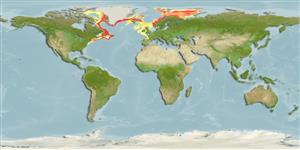Environment: milieu / climate zone / depth range / distribution range
Écologie
marin benthopélagique; non migrateur; profondeur 100 - 1000 m (Ref. 1371), usually 300 - 500 m (Ref. 54573). Temperate; 0°C - 4°C (Ref. 1371); 82°N - 37°N, 95°W - 61°E (Ref. 54573)
North Atlantic: Norfolk Canyon and George Bank north to Labrador, Davis Strait, eastern and western Greenland, Iceland, and from the Irish Atlantic slope north to Faeroe Islands, Norwegian coast, to Spitzbergen, and to the Barents Sea.
Length at first maturity / Taille / Poids / Âge
Maturity: Lm 54.3 range ? - ? cm
Max length : 110 cm TL mâle / non sexé; (Ref. 35388); âge max. reporté: 25 années (Ref. 1371)
Épines dorsales (Total): 0; Épines anales 0. Snout short, rather strongly pointed; mouth small, inferior. Underside of head almost entirely naked. Pyloric caeca about 19 or 20. Overall color is gray, darker ventrally on trunk; anal fin dark-edged, first dorsal and pectoral fins dusky (Ref. 1371). Front end of dorsal fin spine is serrated (Ref. 35388).
Epibenthic, in deep waters down to 2740 (Ref. 58426). Adults are commonly found in about 300-500 m depth. Temperature preferences appear to range from about 1-4°C, although bottom temperatures below 0°C have been recorded at capture depths. Amphipods predominate in the diet, although polychaetes and various natant crustaceans are also important. Also feed on bivalves, isopods, echinoderms (notably ophiuroids), and ctenophores (Ref. 1371). Batch spawner (Ref. 51846).
Cohen, D.M., T. Inada, T. Iwamoto and N. Scialabba, 1990. FAO species catalogue. Vol. 10. Gadiform fishes of the world (Order Gadiformes). An annotated and illustrated catalogue of cods, hakes, grenadiers and other gadiform fishes known to date. FAO Fish. Synop. 125(10). Rome: FAO. 442 p. (Ref. 1371)
Statut dans la liste rouge de l'IUCN (Ref. 130435)
Menace pour l'homme
Harmless
Utilisations par l'homme
Pêcheries: commercial
Outils
Articles particuliers
Télécharger en XML
Sources Internet
Estimates based on models
Preferred temperature (Ref.
123201): 0.8 - 7, mean 3.2 °C (based on 434 cells).
Phylogenetic diversity index (Ref.
82804): PD
50 = 0.5312 [Uniqueness, from 0.5 = low to 2.0 = high].
Bayesian length-weight: a=0.00398 (0.00248 - 0.00639), b=3.19 (3.05 - 3.33), in cm total length, based on LWR estimates for this species & (Sub)family-body (Ref.
93245).
Niveau trophique (Ref.
69278): 3.8 ±0.49 se; based on food items.
Generation time: 28.2 ( na - na) years. Estimated as median ln(3)/K based on 1
growth studies.
Résilience (Ref.
120179): Faible, temps minimum de doublement de population : 4,5 à 14 années (tm=15; tmax=25; Fec=25,000).
Prior r = 0.32, 95% CL = 0.20 - 0.50, Based on 1 stock assessment.
Fishing Vulnerability (Ref.
59153): High to very high vulnerability (75 of 100).
Climate Vulnerability (Ref.
125649): Moderate vulnerability (41 of 100).
Nutrients (Ref.
124155): Calcium = 12.2 [5.7, 24.0] mg/100g; Iron = 0.198 [0.103, 0.362] mg/100g; Protein = 16.6 [14.5, 18.7] %; Omega3 = 0.328 [0.147, 0.688] g/100g; Selenium = 32.3 [13.1, 73.1] μg/100g; VitaminA = 16.5 [3.6, 76.4] μg/100g; Zinc = 0.546 [0.348, 0.859] mg/100g (wet weight); based on
nutrient studies.
